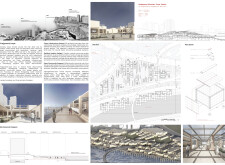5 key facts about this project
### Overview
Located at 19-4 Hwigyeong-dong, Dongdaemun-gu, Seoul, Korea, the Hwigyeong Rainwater Pump Station addresses pressing issues of urban flooding and ecological resilience. This facility seeks to mitigate the impacts of climate change on the urban environment while enhancing community connectivity and ecological stability. The design reflects an understanding of the historical relationship between the Han River and its urban settings, aiming to restore disrupted natural and social dynamics through a comprehensive green infrastructure system.
### Site Layout and Spatial Organization
The project features a carefully considered site plan that incorporates multifunctional spaces, merging residential, recreational, and infrastructural elements. Circulation pathways facilitate interaction between the rainwater management facility and the surrounding urban fabric, promoting community engagement. Open public spaces, including plazas and waterfront areas, enhance connectivity and serve essential infrastructure needs. Additionally, modular flexibility in design accommodates seasonal variations in rainfall, allowing spaces to adapt to the community's evolving needs.
### Structural Framework and Materiality
The design employs a selection of materials that prioritize both functionality and aesthetics. Concrete provides structural durability, while steel is utilized for its flexibility and strength in modular components. Glass is introduced in facades and spatial divisions to maximize natural light and visual access, and wood is incorporated in interior areas to create a warm atmosphere. Permeable pavement is strategically used in landscaping to support stormwater management and bolster environmental sustainability. The interplay of these materials demonstrates a commitment to achieving modern utility within an integrated ecological framework.



















































